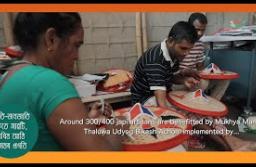সমাজ কল্যাণ বিভাগ
- 'প্ৰজ্ঞা অসম' কুইজ
- Advantage Assam
- Agriculture Department, Assam
- Animal Husbandry and Veterinary Department, Assam
- Assam Employment And Labour Department
- Assam Health And Family Welfare Department
- Assam Police
- Assam Power Distribution Company Limited
- Assam Science And Technology Department
- Assam Skill Development Mission (ASDM)
- Chief Minister Samagra Gramya Unnayan Yojana
- ক্ৰিয়েটিভ কৰ্ণাৰ
- Cultural Affairs Department, Assam
- Department of Education, Govt. of Assam
- Discover Assam
- Environment and Forests Department, Assam
- Finance Department, Assam
- Gyan Bharati
- Inspiring Assam
- Social Welfare Department
- Transport Department, Assam
- Yoga
- প্ৰাগজ্যোতিষৰ জিলিঙনি
কন্যা শিশুৰ ক্ষেত্ৰত এক সবল সামাজিক স্থিতি গঢ়ি তোলাৰ উদ্দেশ্যে পৰামৰ্শৰ আহ্বান
Start Date: 22-01-2019
End Date: 31-12-2022
যিসময়ত সমাজৰ মহিলাই অসীম ধৈৰ্য, সাহস আৰু একাগ্ৰতাৰে বিভিন্ন দিশত ...
বিতং তথ্য গোপন কৰক













Bhawna 5 বছৰ 6 হিচাপপূৰ্বে
They live in war zones
The long-term effects of growing up in a conflict zone are devastating and UNICEF estimates that 48.5 million children worldwide are missing school because of wars and conflicts.
Girls living in conflict-affected countries are 90% more likely to be out of secondary school than those living in peace.
Attacks on girls' schools also mean many parents are afraid to send their daughters to school.
Bhawna 5 বছৰ 6 হিচাপপূৰ্বে
Too few female teachers
The lack of female teachers in some countries can make school a daunting experience for girls. The presence of more women would provide a girl-friendly environment that would put young girls at ease.
In the United States, about three-quarters of school teachers are female. But in African countries such as Liberia and the Central African Republic only about one in five primary teachers are women.
Bhawna 5 বছৰ 6 হিচাপপূৰ্বে
Poor sanitation
In many parts of the world it’s not as easy as raising your hand and asking to go to the toilet.
Many girls - particularly adolescents who are menstruating - don't go to school because of a lack of privacy, unavailability of sanitary disposal facilities and water shortages.
In parts of sub-Saharan Africa and other regions, girls can miss out on up to five days of school per month or stop going to school entirely because of insufficient access to water and hygiene facilities
Bhawna 5 বছৰ 6 হিচাপপূৰ্বে
Dangerous journeys
Most parents are unwilling to allow their daughters to walk long distances to school or take routes that could be dangerous.
During violent conflicts, girls are deliberately targeted by armed groups and government forces. They often suffer sexual violence, abduction, intimidation and harassment.
A study in India in 2016 found that half of all girls were sexually harassed on the way to school - including being leered at, pinched or groped.
Bhawna 5 বছৰ 6 হিচাপপূৰ্বে
5. Child/domestic labour
Girls often stay home to take care of younger siblings and bear the main burden of housework. While educating a boy is considered a sound investment, it is sometimes considered to be a waste of time for girls.
Many girls begin working as early as five years old - mainly in agriculture or in homes as domestic servants. Child domestic workers are particularly vulnerable to trafficking, forced labour, sexual violence and many health issues.
Bhawna 5 বছৰ 6 হিচাপপূৰ্বে
Lack of funding
Funding is an important issue when looking at reasons why girls aren’t in school. Education for girls is often the lowest budget priority in many countries.
Daughters are perceived to be less valuable once educated, and less likely to abide by the will of the father, brother or husband. Often male siblings will be given the chance to attend school instead.
But educating girls and young women increases a country's productivity and contributes to economic growth
Bhawna 5 বছৰ 6 হিচাপপূৰ্বে
3. Violence at school
Not only is this a violation of their human rights, it is also one of the most common causes for girls to drop out of school.
An estimated 246 million girls and boys are harassed and abused on their way to and at school every year - with girls particularly vulnerable. In Africa, half of all children said they had been bullied at school.
18 million girls aged 15 to 19 are victims of sexual violence - often leading to school dropout
Bhawna 5 বছৰ 6 হিচাপপূৰ্বে
Pregnancy
In many parts of the world, girls who are pregnant - regardless of their circumstances - will be excluded from school.
Many do not return after giving birth due to those rules, stigma, fees, lack of childcare and the unavailability of flexible school programmes.
About 16 million girls aged 15 to 19 and some one million girls under 15 give birth every year—most in low- and middle-income countries, according to the World Health Organization.
Bhawna 5 বছৰ 6 হিচাপপূৰ্বে
Early marriage
Too often marriage is seen as a higher priority than education. The low value attached to girls’ schooling means few other options are available to them.
Boys can be affected but most victims of child marriage are girls. It is estimated that every year 15 million girls are married before they turn 18. After their wedding they leave the education system and, because they have fewer educational skills, they and their families are more likely to live in poverty.
Sandeep Shaw 5 বছৰ 7 হিচাপপূৰ্বে
Yes, our society is indeed lagging behind to ensure the safety for the girls.
In order to safeguard their rights the basic step to be taken is to impose strict law for female foeticide, mental and physical abuse and violation of human rights.The rituals of child marriage and dowry system should be eliminated.